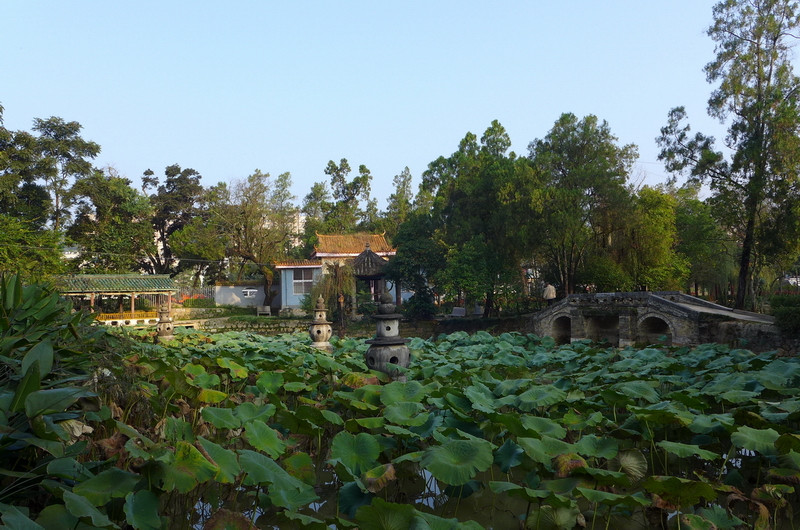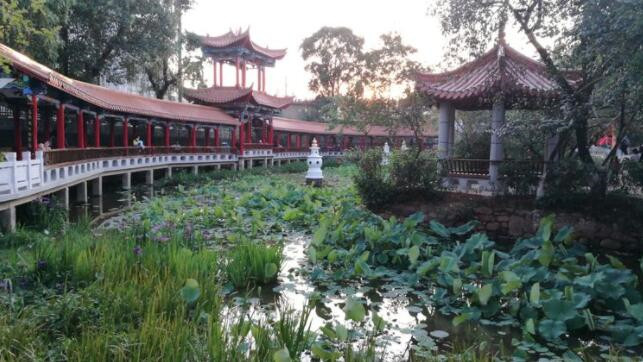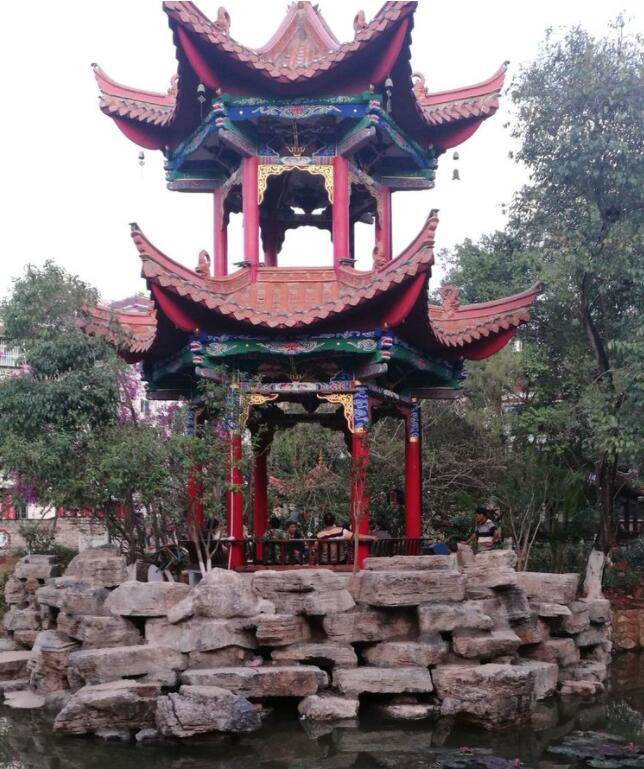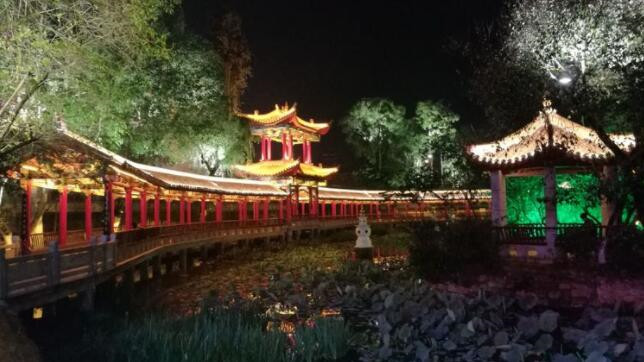Puyi Park in Mojiang County, Puer
Overview
Chinese Name: 墨江普益公园
English Name: Puyi Park in Mojiang County, Puer
Location: South of Mojang Hani Autonomous County, Yunnan Province
Historical Legacy
In the twelfth year of the Republic of China (1923), the venerable “Shejiting” (社稷堂), a revered structure of the Qing dynasty, was graciously renamed the “Puyi Society” (普益社). A decade later, in the twenty-second year of the Republic (1933), a beautifully landscaped garden emerged, aptly named “Puyi Park” (普益公园) in homage to the Puyi Society. Spanning 0.87 hectares, this park is adorned with winding paths, enchanting pavilions, graceful arch bridges, and tranquil ponds, all flourishing with a vibrant tapestry of flowers and trees across the changing seasons.

Scenic Splendor
To the west, a majestic avenue lined with emerald cypress invites leisurely strolls, while to the south stands the historically rich complex of the “Puyi Society,” where the “Chenyao Library” (臣尧图书馆) rests. Upon the library’s stately columns hangs an elegant couplet: “Both banks of the crepe myrtle are resplendent; the first floor exhibits paintings from past to present,” encapsulating the serene beauty and cultural depth of Puyi Park.
Restorative Endeavors
Following the establishment of the People’s Republic of China, the early 1960s witnessed the benevolence of the county people’s committee, which allocated funds to restore and rejuvenate the park, erecting pavilions and a cultural tea house for the community’s enjoyment. Unfortunately, during the tumultuous Cultural Revolution from 1966 to 1976, Puyi Park endured significant deterioration. Yet, in 1983, the People’s Government of Mojang Hani Autonomous County generously invested 100,000 yuan for restoration efforts, resulting in a picturesque water corridor, newly constructed pavilions, and the addition of a Workers’ Club to the eastern section of the park.

A Treasured Retreat
Puyi Park now flourishes as a beloved oasis of leisure, affectionately dubbed the “Little Cuihu Lake of Mojang.” Nestled in Lianzhuzhen, Mojang County, Pu’er City, it was originally formed from the Puyi Society and a quaint garden, leading to its name. The “Puyi Society,” previously known as “Shejiting” in the Qing era, served as a sacred locale for venerating the land and honoring the agricultural deity, Shennong. The name “Puyi” embodies the essence of universal benefit, transcending distinctions of gender and ethnicity.

Cultural Charm and Design
Within Puyi Park, the landscape features alluring embankments encircling serene ponds, meandering pathways, picturesque pavilions, and elegant arch bridges, all framed by a flourishing array of seasonal blossoms. The architectural ensemble includes a central hall, a quaint pavilion, a long corridor, a lively courtyard, and six charming pavilions, each adorned with classic couplets that reflect a rich cultural ethos—thus earning its title as the “Little Cuihu Lake of Mojang.”

Architectural Elegance
The park’s design mirrors the renowned gardens of Jiangnan (江南), a rarity in the southwestern region, integrating sophisticated scenic techniques such as view concealment, landscape suppression, framing vistas, and striking contrasts, resulting in an exquisitely crafted and ethereal retreat. Puyi Park has undergone a splendid transformation through thoughtful enhancement and renovation, now vibrant with life as local residents gather to revel in its restored beauty, celebrating both legacy and leisure in this enchanting haven.
Travel Tips for Visiting Shejiting
Location and Accessibility:
Getting There: Check local transportation options, such as buses or taxis, to reach Shejiting. If you’re traveling from nearby cities, research train or bus routes that stop in Lianzhuzhen or Mojang County.
Nearby Attractions: Consider planning your visit as part of a larger tour of Mojang County, which may include Puyi Park and other cultural sites.
Best Time to Visit:
Seasonal Considerations: Visit during spring or autumn when the weather is mild and the gardens are most stunning with blooming flowers. Avoid the rainy season for a more enjoyable outdoor experience.
Local Events: Check if there are any festivals or cultural events happening during your visit, as they can provide a richer experience and insight into local traditions.
Cultural Etiquette:
Respect for Traditions: When visiting places of historical significance, maintain a respectful demeanor. Avoid loud conversations and follow any posted guidelines.
Photography: Be considerate when taking photos. Always check if photography is allowed, particularly inside the library or any designated sacred areas.
Exploring the Grounds:
Guided Tours: Consider joining a guided tour to gain a deeper understanding of Shejiting’s history and significance. Knowledgeable guides can share fascinating stories and insights that enhance your visit.
Walking Paths: Wear comfortable shoes and take your time exploring the winding paths, pavilions, and scenic spots within the gardens. The layout encourages leisurely exploration.
Amenities and Facilities:
Rest Areas: Look for benches and pavilions to rest and enjoy the view. Bring a water bottle to stay hydrated, especially during warmer months.
Food and Refreshments: Check for nearby food options. Some parks may have small cafes or vendors; however, consider packing snacks for a picnic in the garden.
Engagement with Local Culture:
Interacting with Locals: Don’t hesitate to engage with local residents or park staff. They can offer tips, stories, and perhaps even invite you to local events or traditions.
Souvenirs: Look for local crafts or souvenirs to remember your visit. Supporting local artisans helps sustain their cultural heritage.
Safety Precautions:
Personal Belongings: Keep your belongings secure, especially in crowded areas. Pay attention to your surroundings.
Health and Safety: If you have any allergies (to plants, for instance), be mindful while exploring the gardens.
Language Considerations:
Communication: While some locals may speak English, it’s helpful to learn a few basic phrases in Mandarin or carry a translation app to facilitate communication.
Respect the Environment:
Leave No Trace: Be mindful of litter and dispose of trash properly. Respect the natural beauty and cultural significance of the site.
Wildlife Awareness: If you encounter local wildlife, observe from a distance and do not feed or disturb them.













